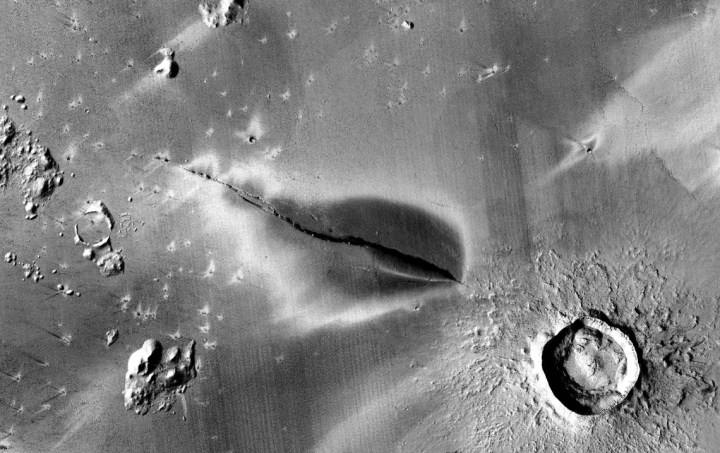
The surface of Mars is covered in faults and scars which show that the planet was once tectonically active, with activity beneath the surface that formed structures like valleys and trenches. But most of this activity took place billions of years ago, and now Mars is thought to be largely inactive.
However, new research challenges this assumption, by showing evidence that there could have been volcanoes erupting on Mars within the last 50,000 years. Astronomers the University of Arizona’s Lunar and Planetary Laboratory and the Planetary Science Institute looked at data from Mars orbiters and found a newly-discovered volcanic deposit in the Cerberus Fossae system in the Elysium Planitia region which they believe is younger than previously discovered deposits.
“When we first noticed this deposit, we knew it was something special,” said study co-author Jeff Andrews-Hanna in a statement. “The deposit was unlike anything else found in the region, or indeed on all of Mars, and more closely resembled features created by older volcanic eruptions on the moon and Mercury.”
The evidence of the composition of the material suggests that it was formed relatively very recently when magma erupted from the surface due to expanding gasses below the surface. It would have been a dramatic event and could have sent ash flying as high as six miles into the air.
“This may be the youngest volcanic deposit yet documented on Mars,” said lead study author David Horvath. “If we were to compress Mars’ geologic history into a single day, this would have occurred in the very last second.”
The location of the deposit is around 1,000 miles from NASA’s InSight lander. InSight uses its seismometer to study marsquakes, and over its period of observation, it has detected two marsquakes that originated from the Cerberus Fossae area. Along with the deposit evidence, this suggests that Mars could still have activity going on beneath its surface that we were previously unaware of.
“The young age of this deposit absolutely raises the possibility that there could still be volcanic activity on Mars, and it is intriguing that recent marsquakes detected by the InSight mission are sourced from the Cerberus Fossae,” Horvath said.
This new evidence is challenging the assumption that Mars is inactive. There could even be conditions hospitable to life beneath its surface.
“All these data seem to be telling the same story,” Andrews-Hanna said. “Mars isn’t dead.”
The research is published in the journal Icarus.
Editors' Recommendations
- Neptune isn’t really dark blue, new study demonstrates
- Map of Mars shows the location of ice beneath the planet’s surface
- NASA’s InSight lander looks into Mars to study the planet’s core
- One of James Webb’s 17 instrument modes isn’t working
- Perseverance rover finds conditions where life could have thrived on Mars




